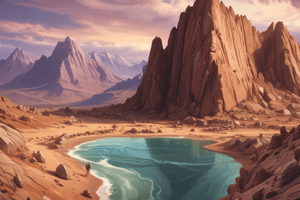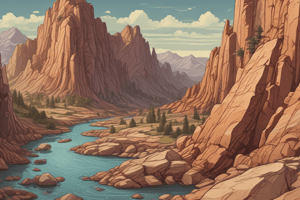Podcast
Questions and Answers
What is the primary difference between intrusive and extrusive igneous rocks?
What is the primary difference between intrusive and extrusive igneous rocks?
- Their location of formation (correct)
- Their texture
- Their composition
- Their age
What is the primary process involved in the formation of sedimentary rocks?
What is the primary process involved in the formation of sedimentary rocks?
- Metamorphism
- Accumulation and compression of particles (correct)
- Magmatic differentiation
- Weathering and erosion
What type of texture do metamorphic rocks often exhibit?
What type of texture do metamorphic rocks often exhibit?
- Layered or bedded
- Fine-grained
- Foliated or non-foliated (correct)
- Coarse-grained
What is the term for the continuous process by which rocks are formed, transformed, and destroyed?
What is the term for the continuous process by which rocks are formed, transformed, and destroyed?
How does the Geological Survey of India (GSI) classify rocks?
How does the Geological Survey of India (GSI) classify rocks?
What is the term for the process by which igneous rocks are formed from the cooling and solidification of magma or lava?
What is the term for the process by which igneous rocks are formed from the cooling and solidification of magma or lava?
Flashcards are hidden until you start studying
Study Notes
Igneous Rocks
- Formed from the cooling and solidification of magma or lava
- Can be either intrusive (formed below the Earth's surface) or extrusive (formed above the Earth's surface)
- Characteristics:
- Coarse-grained texture (intrusive)
- Fine-grained texture (extrusive)
- May contain gas bubbles or minerals
- Examples: granite, basalt, obsidian
Sedimentary Rocks
- Formed from the accumulation and compression of mineral or organic particles
- Can be formed through:
- Mechanical weathering (erosion and deposition)
- Chemical weathering (chemical reactions)
- Organic activity (shell formation, etc.)
- Characteristics:
- Layered or bedded structure
- May contain fossils or other inclusions
- Examples: shale, limestone, sandstone
Metamorphic Rocks
- Formed from the alteration of existing rocks under high pressure and temperature conditions
- Can be formed through:
- Mountain-building processes
- Tectonic plate movement
- Characteristics:
- Foliated (banded or layered) or non-foliated texture
- May exhibit mineral changes or new mineral formation
- Examples: marble, slate, quartzite
Rock Cycle
- The continuous process by which rocks are formed, transformed, and destroyed
- Involves the three main types of rocks (igneous, sedimentary, metamorphic) and their interactions
- Processes involved:
- Magmatic differentiation (igneous formation)
- Weathering and erosion (sedimentary formation)
- Metamorphism (metamorphic formation)
- Melting and cooling (igneous formation)
Rocks Classification in India
- The Geological Survey of India (GSI) classifies rocks into four categories:
- Archaean (>2500 Ma)
- Proterozoic (2500-541 Ma)
- Phanerozoic (541 Ma-present)
- Classification is based on age, composition, and tectonic setting
- Important rock formations in India include:
- The Indian Shield ( ancient cratons and mobile belts)
- The Himalayan Orogen ( collisional mountain-building)
Igneous Rocks
- Formed from cooling and solidification of magma or lava
- Can be either intrusive (formed below Earth's surface) or extrusive (formed above Earth's surface)
- Characteristics:
- Coarse-grained texture (intrusive)
- Fine-grained texture (extrusive)
- May contain gas bubbles or minerals
- Examples: granite, basalt, obsidian
Sedimentary Rocks
- Formed from accumulation and compression of mineral or organic particles
- Can be formed through:
- Mechanical weathering (erosion and deposition)
- Chemical weathering (chemical reactions)
- Organic activity (shell formation, etc.)
- Characteristics:
- Layered or bedded structure
- May contain fossils or other inclusions
- Examples: shale, limestone, sandstone
Metamorphic Rocks
- Formed from alteration of existing rocks under high pressure and temperature conditions
- Can be formed through:
- Mountain-building processes
- Tectonic plate movement
- Characteristics:
- Foliated (banded or layered) or non-foliated texture
- May exhibit mineral changes or new mineral formation
- Examples: marble, slate, quartzite
Rock Cycle
- Continuous process by which rocks are formed, transformed, and destroyed
- Involves the three main types of rocks (igneous, sedimentary, metamorphic) and their interactions
- Processes involved:
- Magmatic differentiation (igneous formation)
- Weathering and erosion (sedimentary formation)
- Metamorphism (metamorphic formation)
- Melting and cooling (igneous formation)
Rocks Classification in India
- The Geological Survey of India (GSI) classifies rocks into four categories based on:
- Age
- Composition
- Tectonic setting
- Important rock formations in India include:
- The Indian Shield (ancient cratons and mobile belts)
- The Himalayan Orogen (collisional mountain-building)
- Time periods for rock classification:
- Archaean (>2500 Ma)
- Proterozoic (2500-541 Ma)
- Phanerozoic (541 Ma-present)
Studying That Suits You
Use AI to generate personalized quizzes and flashcards to suit your learning preferences.




